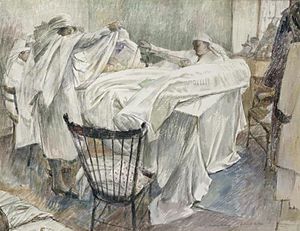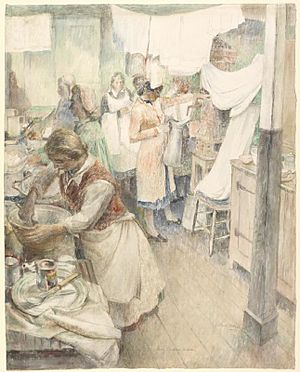Erlund Hudson facts for kids
Quick facts for kids
Erlund Hudson
|
|
|---|---|
| Born | 18 February 1912 Devon, England
|
| Died | 9 March 2011 (aged 99) |
| Nationality | British |
| Education |
|
| Known for | Painting, drawing |
Eleanor Hudson, known professionally as Erlund Hudson, was a talented British artist. She was born on February 18, 1912, and passed away on March 9, 2011. Erlund was famous for her beautiful watercolour paintings, etchings (a type of printmaking), and designs. She is especially remembered for her artworks showing women working hard during World War II and her later paintings of ballet dancers.
Contents
A Young Artist's Start
Erlund Hudson was born in St Marychurch, a town near Torquay in Devon, England. She was the youngest of seven children. Her father, Henry Hudson, was a businessman from Liverpool, and her mother, Helen Ingeborg Olson, was Norwegian-American.
When Erlund was ten years old, she had to stay in bed for a whole year because of a back injury. During this time, she spent many hours drawing, which helped her discover her love for art. She later went to Torquay School of Art. After that, she earned a spot at the Royal College of Art (RCA) in London, where she studied engraving.
At the RCA, Erlund learned from famous artists like Malcolm Osborne and Robert Austin. She finished her diploma in 1937 and won several awards for her drawing. She also received a special scholarship that allowed her to travel. In 1937, while still a student, Erlund was chosen to join the Royal Society of Painter-Printmakers. In 1939, she also became a member of the Royal Watercolour Society.
In 1938 and 1939, Erlund traveled all over Italy. She returned to Britain just days before World War II began, which meant she avoided being stuck in Italy during the war.
Art During World War II
When World War II started, Erlund Hudson moved to Leicestershire and then to Kent. She even helped deliver her sister-in-law's baby, who was born early during a big thunderstorm!
In Leicestershire, Erlund lived with her brother, who was a vicar. There, she sketched local women who were preparing dried herbs and flowers. These were sent to hospitals to be used as medicine. She also drew pictures of canteens in Leicester, where she helped pack care packages for prisoners of war.
Later, Erlund moved to a flat in Earls Court, London. She saw firsthand the damage and sadness caused by the Blitz, which was a series of bombings on London. She volunteered to drive a mobile canteen, which was a laundry van changed into a tea and sandwich truck. She served hot drinks and food to rescue workers at bomb sites. She remembered seeing terrible scenes after buildings were bombed.
Even though she saw these sad things, Erlund chose to focus her art on showing women volunteers working hard for the war effort. She created hundreds of paintings and drawings during the war. Her teacher, Robert Austin, suggested she contact the War Artists' Advisory Committee (WAAC). The WAAC bought six of her drawings, including Village Women Drying Wild Herbs and WVS Bandage Making. These artworks were shown in WAAC exhibitions at the National Gallery during the war. Today, they are kept at the Imperial War Museum.
Life After the War
After the war, Erlund Hudson used her artistic skills to design costumes and scenery for famous dance companies like Sadler's Wells and Ballet Rambert. Her interest in ballet led her to meet Nesta Brooking, who had her own ballet school. Erlund became the artistic director of the Brooking School of Ballet.
Erlund and Nesta became very close friends and companions for life, sharing their lives until Nesta passed away in 2006. Erlund, Nesta, and the musical director Norman Higgins worked together on many projects. They collaborated with ballet experts and even worked with the BBC. They also produced Nesta's own ballet shows.
Erlund was also a very good portrait painter, mostly using watercolours. She continued to show her art in Britain, Scandinavia, Canada, and the United States. In the 1960s, she left the art societies she was part of. She then worked as a restorer for The Rocking Horse, an antique shop in St John's Wood.
In 2002, a company called Black Star Press reprinted some of her best etchings. In 2007, the Imperial War Museum held a special party to honor Erlund. She attended with two other artists from her time, Phyllis Diamond and Malvina Cheek. Their conversation was recorded by the BBC and broadcast on the Woman's Hour radio program.
Besides the Imperial War Museum, Erlund Hudson's artworks can be found in many other important collections. These include the British Museum, Dudley Museum and Art Gallery, the Wellcome Library, the National Gallery of Canada, and the Yale Center for British Art.
Artistic Groups and Memberships
Erlund Hudson was a member of several important art organizations:
- 1937: She became an associate member of the Royal Society of Painter-Printmakers.
- 1939: She became an associate member of the Royal Watercolour Society.
- 1946: She became a full member of the Royal Society of Painter-Printmakers.
- 1949: She became a full member of the Royal Watercolour Society.
She was also a member of the Chicago Print Society and the Society of Artist Print Makers.



